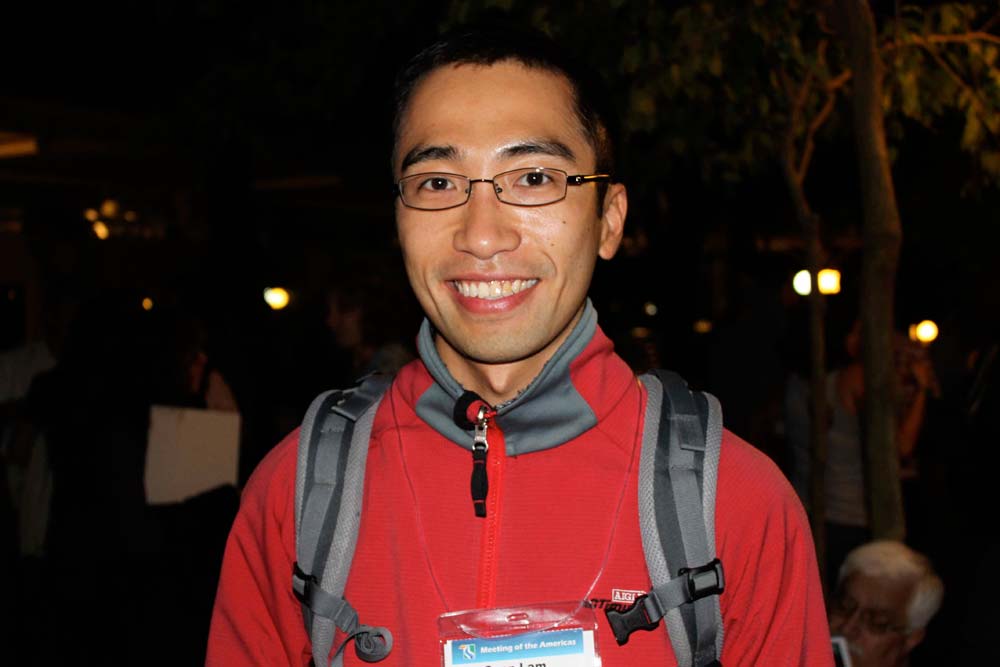8 August 2010
What brings people to the 2010 Meeting of the Americas?
Posted by Michael McFadden
At the Meeting of the Americas icebreaker, a casual sampling by AGU bloggers revealed that researchers have come from around the globe to discuss new work, make connections with colleagues, and visit parts of the globe they wished to see.
Anna Plotzki of the University of Bern, Switzerland was already in South America—Bolivia, to be specific, where she is working on her PhD on the evolution of Holocene landscapes in the lowlands of that country. At her first AGU meeting, Anna says “I hope to get contacts with people doing research in the same area” of study. After the meeting, she’s back to Bolivia for 2 months more field work.
Mike Brown of the University of Maryland in the United States has attended so many AGU meetings—dozens, he estimates—that he would have to go back through his records to count them all. Brown is an applied metamorphic petrologist who has organized a session on the formation of mountain belts way back when the Earth was hotter. During in the Archaean, Brown notes, the planet was so hot that there weren’t any mountains. The crust then oozed “rather like brie cheese,” too soft to hold up a mountain range.
En route to Foz do Iguaçu, Jennifer Harden took one of the field trips offered in association with the Meeting of the Americas – a 3-day excursion in Amazonia. One of the highlights, says Harden, a soil scientist with the U.S. Geological Survey in California , was seeing the black waters of the Rio Negro flowing side-by-side with the yellow waters of the Rio Solimões where the two meet, and watching pink dolphins and grey dolphins feeding at the curtain-like interface of black and yellow. In Jennifer’s research, she is studying how the carbon cycle of high northern latitudes contrasts with that of the tropics.
Experimental physicists Giorgio Caranti (left) and Andrés Pérez Hortal (right) left behind electrified water droplets in their laboratory in neighboring Argentina to come to the meeting. By attracting other droplets, those energized orbs grow quickly. A new way for making rain may ultimately come of this research at the Universidad Nacional de Córdoba, say Hortal, a doctoral student, and Caranti, his advisor. It’s Hortal’s first AGU meeting, although Caranti says he has been to the Fall Meeting in San Francisco once. Why come to an Earth and space science meeting to discuss a physics experiment? Because an AGU meeting will bring together atmospheric physicists, Caranti explains.
Besides convening a session on regional ocean observing systems, Keith Alverson says he will speak at the townhall on hazards Tuesday evening. As an oceanographer in Paris, France with the Intergovernmental Oceanographic Commission of UNESCO, Alverson is working to create a global ocean observing system that would offer a way to monitor, day-to-day and year-to-year, key ocean characteristics. What’s the hazards connection? That same system could do double duty, he notes, on the rare, but critical occasions when tsunamis strike.
Perhaps no one traveled further to the meeting than Sean Lam of the University of Western Australia. He was traveling for 26 to 30 hours, he estimates, landing ultimately 11 time zones from his home. On Monday, Lam gives a talk about his work in atmospheric chemistry, using modeling and simulations to study how secondary pollutants form as a plume of industrial chemical emissions flows downwind. On the verge of earning his doctorate, Lam is combining his long journey to his first AGU meeting with extensive further travels. Next comes wandering through other South American countries, including Argentina, Bolivia, and Peru. Then north to California. “There won’t be much opportunity for me to ever come here again. I might as well” make this journey, Lam says. “I finished my thesis,” he adds, with a smile.
– Peter Weiss, AGU science writer








 GeoSpace is a blog on Earth and space science, managed by AGU’s Public Information staff. The blog features posts by AGU writers and guest contributors on all sorts of relevant science topics, but with a focus on new research and geo and space sciences-related stories that are currently in the news.
GeoSpace is a blog on Earth and space science, managed by AGU’s Public Information staff. The blog features posts by AGU writers and guest contributors on all sorts of relevant science topics, but with a focus on new research and geo and space sciences-related stories that are currently in the news.
Nice compilation! Although it was not at Iguassu, I found this to be the most exciting comment: “seeing the black waters of the Rio Negro flowing side-by-side with the yellow waters of the Rio Solimões where the two meet, and watching pink dolphins and grey dolphins feeding at the curtain-like interface of black and yellow.” Wow!!